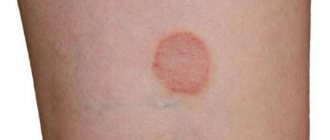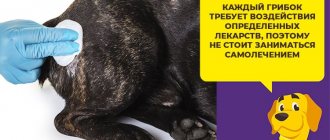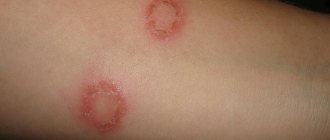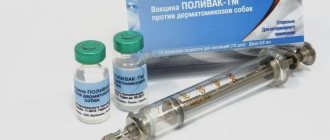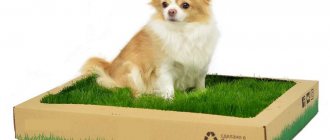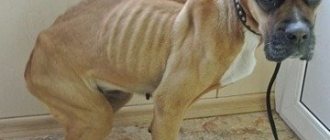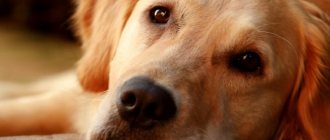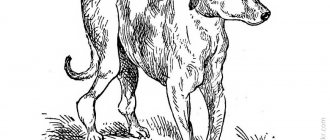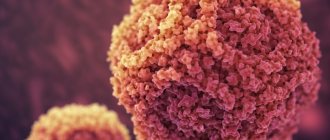4.5 / 5 ( 2 voices)
Dog breeders often encounter problems associated with dermatological pathologies. These include allergic, infectious, and fungal irritations. Ringworm is a type of fungal disease that poses a danger to animals and people. Spores quickly penetrate the epidermis, spread and are transmitted by touching or using common household items.
Also read the article on the topic: “What to do if your dog has lichen: symptoms with photos, treatment and prevention.”
Features of infection
Trichophytosis and microsporium are fungi that cause a disease called lichen. Regardless of the pathogen, the symptoms and course of the disease are similar. The root causes can only be identified through laboratory tests. The spores that give rise to the fungus are distributed throughout the environment. They can withstand low and high temperatures, dampness and drought. They live up to 18-20 months, often settling on living organisms.
Spores germinate in the upper and deep layers of the skin of a dog or person, destroying not only the structure of the epidermis, but also the hair follicle - the hairs break and fall off. This is why ringworm got its name . Although there are other species in nature.
Infection can occur in several cases:
- Indirect contact with an infected animal (sharing dishes, combs, toys, blankets and clothing);
- Walking in little-known places (pathogenic spores are found on almost all environmental objects - in the ground, bushes, on stones, in mosses, etc.);
- Direct contact with an infected person, pet, urban pest (rat, pigeon).
Experts believe that mass infections occur during the cold season (autumn, winter). During this period, pets do not receive the required amount of ultraviolet radiation and vitamin D. Animals are often weakened by colds.
The main and most common cause of infection is instability of the immune system . Puppies, sick pets, and dogs after a long course of antibiotic treatment are more susceptible to lichen.
Incorrect or ineffective indoor ventilation, dampness and drafts have a positive effect on the development and spread of spores. Therefore, animals kept in nurseries are especially likely to contract dermatoses.
Origin of trichophytosis
Trichophytosis is an infectious disease caused by a fungus found on the skin of sick animals and common objects (bed, food bowls, toys, etc.). There are small-spore fungi, which live on the hair of rodents and other small animals, and large-spore fungi, which are also found in dogs. The causative agent of ringworm is able to remain active on the animal’s body for several years. However, directed sunlight turns out to be detrimental to the fungus, destroying it in a few hours.
The most likely way to catch trichophytosis in dogs is direct contact; young animals get sick more often and more severely, with the peak incidence occurring in autumn and winter. The risk group includes stray animals, but due to the high survivability of the fungus, which can persist for several years, pets are also at risk. Factors such as overcrowding, malnutrition, monotonous food, the presence of small cuts, and unsanitary conditions contribute to the occurrence of infection.
Symptoms and signs
Like all dermatoses, lichen manifests itself by external signs. First of all, itchy redness and peeling occur. Then a number of specific symptoms characteristic of this form appear:
- Round red bumps (2-5 cm in diameter);
- Severe hair loss in affected areas, formation of crusts along the edges of wounds (often near the tail, on the head, limbs);
- The skin is peeling and itchy, the pet is restless, trying to get rid of the irritating scabies;
- The wounds remain pale or grayish, but reddish foci of inflammation are visible (in the center or around the area);
- When the disease is advanced, ulcers and blisters with a yellowish liquid appear, the wounds bleed;
- The claws change shape and their density increases.
Symptoms of trichophytosis
- Increased anxiety
- Decreased appetite, refusal to eat
- Bald spots, baldness
- Skin itching, rash
- Peeling of the skin, appearance of crusts on the skin
- Wrinkled skin, dandruff
- Increased body temperature
- Scabies
- Skin redness
- Claw deformity (onychomycosis)
The incubation period for trichophytosis in dogs lasts several weeks. The fungus gets on the animal's skin and releases toxic elements that lead to inflammation of the skin. Next, the spores penetrate deep into the hair follicles, deforming them and thereby causing baldness. At the same time, small round hairless spots, framed by grayish scales, can be seen on your pet’s skin. Scabs appear that the dog tries to lick and scratch. Sometimes suppuration of the hair roots is possible.
An infected animal begins to constantly scratch the area where the fungus has entered. On bare skin that remains smooth, redness, peeling appear, and a crust forms, from under which pus flows. Constant scabies promotes the spread of microbes, the fur in the area where the fungus accumulates becomes pale, brittle, brittle and soon falls out along with the crust, deformation and thickening of the claws occurs. Next, the infection enters the circulatory and lymphatic systems and causes metabolic disorders, which threatens exhaustion. In a particularly advanced case of ringworm in dogs, an increased number of affected areas is observed, and it is possible that bald spots may combine into one large bald patch. Most often, infection develops in the areas of the forehead, eyes, neck, and paws. A sick animal begins to lose weight, its resistance to external irritants decreases, and the quality of its coat deteriorates.
How to tell if your dog is getting ringworm
It is difficult to detect the disease at the first mild stage, but an attentive owner is obliged to pay attention to the pet’s restlessness.
- 2-3 days after infection, lichen begins to multiply and manifests itself in the form of small reddish bumps-inflammations. They bother the dog and cause itching.
- Incubation can last from 10 to 40 days.
- After this, within about a week , the tubercles change to flat spots with a pronounced gray rim - a focus of inflammation. Crusts and scabs form along the edge of the wound, and the hair at the site of the lesion falls out.
- If the animal actively scratches or licks itself, the disease can spread to other parts of the body.
- The structure of the dog’s claw also changes noticeably: the plates become denser, deformed, and may change color.
Advanced stage
The disease itself is not dangerous, especially in the early stages. But without the necessary treatment, it develops into a generalized form of lichen, which means that the affected areas of the skin grow, scabs cover the entire surface of the body. This not only brings some discomfort to the pet, but also promotes further growth and development of bacteria.
The dog scratches the wounds and introduces a new infection, which not only complicates treatment, but also negatively affects the immune system.
Types of disease
There are several variants of this disease with different symptoms. Including pityriasis rosea in dogs, pityriasis versicolor or multicolored.
Shingles
This species is very dangerous for the animal because the rashes can get inside the body. Symptoms: blisters appear on the stomach and thigh, which constantly itch. Then they burst and crusts appear in this place. Festering and hair loss begin.
Ringworm in dogs symptoms
This disease is completely non-contagious; severe itching and suppuration occur. If you do not take any action, the areas will increase. The reason is a genetic factor. In many cases, ringworm in dogs is a symptom of the endocrine system. The difference from other lichens is swelling, spots with pus that spread throughout the body.
All swelling is accompanied by severe pain. It is located on the lower back, cheeks, tail, neck. The spots become yellow. Then a crust with pus appears.
He can live for a very long time.
Diagnostics
After detecting signs of lichen, you should immediately contact the clinic. The use of any drugs may change the indication of subsequent diagnostics or complicate treatment . Several types of tests are used in veterinary practice:
- Glow with a Wood's lamp (fluorescent diagnostics), some types of lichen give the fur a light green or yellow glow, but in its absence one cannot get our hopes up; it is important to carry out a full diagnosis;
- Skin scraping (carried out until drops of ichor or blood appear);
- Sowing wool sprouting around the affected area, a method that requires a long study, because colonies of the fungus must multiply and become noticeable to the human eye (using a microscope);
- Biopsy (used in rare severe cases, may not confirm the presence of lichen).
Diagnosis of lichen in cats and dogs
Having noticed the first signs of lichen, namely bald areas on the body, it is necessary to take the animal to the veterinarian. It will not be superfluous to take precautions: if the lichen turns out to be contagious, then the owner will need treatment. So, you should wear gloves and protect the animal from contact with others.
For an accurate diagnosis, the veterinarian performs a visual examination and examines the body for the presence of spots. This is done using a special Wood's lamp with the lights turned off. The affected areas will begin to glow when exposed to an ultraviolet lamp.
Wood's lamp is an excellent way to diagnose lichen
Next, in the laboratory, the doctor takes a scraping and begins to examine it under a microscope. If necessary, the veterinarian will conduct a bacteriological examination.
How to treat ringworm
- Treatment for ringworm cannot be planned independently. This subtype of the disease is insidious in that it can periodically subside, resetting the symptoms. But it is during this period that the fungus makes its way to the deep layers of the epidermis. The pet should be regularly examined at a veterinary clinic and repeated tests should be carried out to monitor the progress of the infection.
- First of all, when lichen bald patches are detected, the affected areas are washed with boiled warm water. The fur around the wounds is clipped (later burned to prevent the spread of spores). A protective collar is put on the pet, which will prevent it from licking the medicine or healing wounds. It is necessary to isolate the pet from family members and maintain quarantine until complete recovery.
- Scabs and crusts are softened with solutions or ointments and removed using tweezers . An antibacterial or antifungal ointment is applied to the surface of shallow lesions. If the lesions are deep, then the drugs are applied using sterile napkins or infused with a catheter.
- The complex of treatment for ringworm includes antibiotic treatment (injections or oral medications), maintaining the functioning of the liver and immune system . Antiseptic external preparations are used - sprays and shampoos for surface treatment. Traditional methods can be used in parallel, but not instead of drug therapy.
List of medications against ringworm
| Name | Price | Mode of application |
| Local treatment | ||
| Yam BC | 100-120 rubles (20 gram jar) | Ointment for external use, applied to the affected areas of the skin and around 2 times a day until complete healing and new hair sprouts. |
| Fungin | 50 rubles (10 ml) | Spray or drops are applied to the affected epidermis once a day until complete healing |
| Nizoral | 600-650 rubles (bottle) | Diluted in a ratio of 10:1 with water, wash the pet every 3 days, leave the foam for 5 minutes and rinse thoroughly |
| Alezan | 400 rubles (200 ml) | Add 10-15 ml of Alezan soap to 1 liter of water, treat with the solution, washing the affected areas of the skin, removing crusts and scabs |
| Systemic | ||
| Itraconazole | 360 rubles (pack of 15 tablets of 100 mg) | Tablets for oral use, mixed with food once a day, should be used in a dose of 10 mg of active ingredient per 1 kg |
| Griseofulvin | 250 rubles | Mixed into food 2 times a day, 20-50 mg of active ingredient per 1 kg |
| Fluconazole | 50-180 rubles per package (7 capsules of 50 mg each) | Capsules are given with food once a day 10 mg per 1 kg |
| Vaccines | ||
| Microderm | 100 rubles (1 dose) | 0.5-1 ml (depending on weight) is injected intramuscularly twice (once into one back thigh, and after 14 days into the other thigh) |
| Vakderm | 360 rubles (4 ampoules) | 0.5-2 ml are administered similar to the regimen for the previous drug |
Treatment with folk remedies
Traditional methods are allowed only in combination with drug treatment. Certain methods can help in the early stages of the disease. The most common means:
- Cranberry juice (freshly squeezed only) is applied to bald patches and affected areas 5-6 times a day;
- Garlic compresses: garlic cloves are cut in half and the cut area is applied to the affected areas 3 times a day;
- Wounds are treated with iodine solution 1-2 times a day (not too intensely and often so as not to cause a burn);
- Apple cider vinegar is used similar to cranberry juice;
- The condition of the skin is improved by other solutions: birch tar, calendula tincture, onion juice, celandine emulsion, lemon juice and vegetable oil - they are washed into the skin 3-4 times a day.
Danger to dogs and humans
This type of lichen belongs to the category of anthropozoonoses, that is, it is dangerous for both dogs and humans. Owners can become infected from their pet. The disease is especially dangerous for young children and people weakened by the disease, whose immune system is not yet fully functional. To treat the disease, you should immediately contact a dermatologist or infection specialist.
The scary thing about lichen is that if the hair follicles are severely damaged, after the skin is restored, bald patches may remain. If a child catches lichen in early childhood, then without proper treatment he may remain bald. In addition, infectious diseases of the epidermis caused by suppuration pose a separate threat.
If an infected person appears in the house, it is necessary to isolate him from children and other animals. In case of contact, use barrier means, and after examination or treatment, disinfect your hands.
The disease is not dangerous for the animal in its early stages. However, if left untreated for a long time, it can develop into a serious pathological form and cause other infectious problems: dermatitis, bacterial irritations.
Treatment of lichen, as well as prevention of its occurrence, should be a priority for the owner of a sick animal. Yes, fungal pathologies do not have lethal consequences or dangerous effects, but they lead to serious infectious diseases and mental concussions.
Veterinary care at home or a trip to the veterinary clinic
When and why you need to call a veterinarian at home or go to a veterinary clinic.
1. If you just got a cat or dog, but have never had animals before, be sure to show your pet to the veterinarian, especially if the animal was purchased at a poultry market or in other places where animals gather.
2. If you see that something is wrong with your pet, and you know nothing about animal diseases, call a veterinarian or visit a veterinary clinic as soon as possible.
3. If your animal suddenly becomes ill, immediately call a veterinarian or rush to a veterinary clinic.
4. If the painful condition continues for more than a day, this is a reason to contact a veterinarian.
What's better? Call a veterinarian at home or visit a veterinary clinic.
Of course, the main advantage of calling a veterinarian at home is convenience. As a rule, the veterinarian arrives at a convenient time, no need to transport the animal, no need to stand in line.
The second point of a veterinarian coming to your home is the benefit for sick cats or dogs - there is no stress of moving, no stress of visiting a veterinary clinic, no communication with other sick animals.
The main advantage of veterinary clinics is the simultaneous availability in one place of various equipment for conducting additional studies of dogs and cats, and the simultaneous work of different specialists working on this equipment. But very few veterinary clinics have this combination. And you can conduct almost any research at home, but for this you need to call many different specialists.
The initial appointment at home, in the nearest veterinary clinic and in a veterinary clinic equipped with additional equipment is carried out by a general veterinarian - that is, a veterinarian with knowledge and skills in therapy, surgery, obstetrics, eye diseases, infectious diseases, skin problems, nutrition and if your pet’s illness does not goes beyond moderate severity and complexity, then the necessary medical procedures will be immediately carried out and further treatment will be prescribed.
If the animal’s condition is more serious, then the primary doctor decides what and where tests to do, to which surgeon and when to refer the animal, what and where to do additional complex hardware tests - ultrasound, X-ray, computed tomography or MRI, measuring blood pressure, taking an ECG , - perhaps in the future, after receiving research data, a decision will be made on a treatment method or you will be referred to a veterinarian specializing in specific conditions or diseases.
So, the initial examination of cats and dogs and treatment of diseases of any moderate profile will be the same in any veterinary clinic and at home. The cost of such treatment will also be the same with slight variations.
On the other hand, it sometimes happens that immediately after an examination the animal needs to be sent somewhere, in this case the cost at the veterinary clinic will be less, and on call it will be more - due to the time spent by the doctor coming home to the animal - this is the same time that you would spent on visiting the veterinary clinic, but for convenience this time can be paid for.
Once we have decided whether to go to the veterinary clinic or call a veterinarian at home, we decide the next question.
How to choose a veterinarian?
How to choose which veterinarian to call and which veterinary clinic is best to go to?
The best option is if you have already communicated with veterinarians and you have a veterinarian whom you know and trust, then it is better to entrust the initial examination to this doctor.
The second option is information about veterinarians from your friends.
The third option is to call a veterinarian from any call service or visit the nearest veterinary clinic; if everything is successful, then you will have a familiar veterinarian, otherwise you will have to make several attempts in different places.
Everyone strives to improve the quality of their work and therefore the likelihood of encountering a completely illiterate doctor is small, but if you have any doubts or questions - this usually happens if the animal does not recover or the prognosis is very unfavorable - then you should definitely discuss this with a doctor you already know and, if necessary, seek additional advice from one or more veterinarians.
Veterinarian assessment via the Internet
Attempts to evaluate veterinarians and veterinary clinics on the Internet and forums, as a rule, do not provide objective information - because reviews come only from individual patients (usually with a negative outcome of the disease) and only about individual doctors.
On the Internet, it is good to evaluate a specific product (for example, a red teapot) with certain properties that are clear to everyone and a large number of reviews - then you get a more or less objective assessment.
About veterinary clinics on the Internet you can find out what equipment they have and when the doctor works on this equipment, what special services are available in a particular clinic, the general price of services or the cost of specific services (vaccination, castration of cats, sterilization of cats, euthanasia of animals, funeral services - euthanasia , cremation).
When you know a veterinarian, he is the one who knows which veterinary clinic is best to conduct an examination and where to perform a specific operation. Therefore, try to find your veterinarian as soon as possible. Veterinarians who work on call usually always leave their mobile phone and provide advice as needed.
In veterinary clinics, doctors are not allowed to leave their contact details, so it is difficult to contact them - you have to wait for their shift, and if the veterinarian moves to work in another veterinary clinic, then contact may be completely lost.
Call a veterinarian to your home 24 hours – Vet help 24 hours
